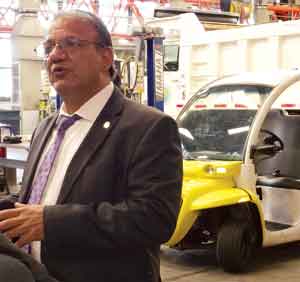Managing Editor
It's Difficult Finding Room for New Fueling Stations in Big Cities
This story appears in the July 25 & Aug. 1 print edition of Transport Topics
NEW YORK — Densely populated cities present a challenge for alternative-fuel infrastructure because often there isn’t enough space, officials at one of nation’s largest waste operations said.
This city’s Department of Sanitation uses some alternative-fuel options, such as compressed natural gas, but is seeking even cleaner burning options for the future, including dimethyl ether, said Kathryn Garcia, the agency’s commissioner, who added that she has to deal with regulatory concerns.
 DiRico by Lorrie Grant/TT
DiRico by Lorrie Grant/TT Dimethyl ether, or DME, is a nontoxic, clean-burning fuel made from natural gas, animal waste or food waste, according to the International DME Association.
“Trash has value because it can be converted into energy,” Garcia said, noting DME is “attractive because it’s very clean and behaves like diesel” when comparing torque and horsepower ratings, but the challenge is getting the fuel into trucks.
“We can measure the usefulness of it in the truck, but we can’t control the infrastructure,” said Deputy Commissioner Rocco DiRico, adding that space is difficult to acquire in the city. While DME uses a smaller, modular scale, in New York City fueling infrastructure needs to be narrow and tall, he said.
The sanitation officials spoke during a press event with Mack Trucks, which provides 98% of the 2,500 refuse trucks used by the city. They are purchased by competitive bid every seven years.
Another challenge, according to Garcia, is regulatory clearance.
“It’s a new fuel for folks at the fire department, and they are highly cautious,” she said.
Garcia said representatives of the New York Fire Department wanted to know more about how combustible the fuel is and other characteristics of the substance. DME ignites through compression and is stored in a fashion similar to propane.
This means that the sanitation department, which has a goal of recycling all trash by 2030, will have to wait on the aid that DME could lend in doing that, according to the officials.
“It will be quite some time,” DiRico said. “We can’t put a timeline on it.”
 Horton by Lorrie Grant/TT
Horton by Lorrie Grant/TT Roy Horton, director of product strategy at Mack, said trucks produced for refuse are the Mack LR, launched last year, and the TerraPro series.
The Greensboro, North Carolina- based manufacturer announced in 2013 that it would begin production of DME-powered Pinnacle axle-back models in 2015, equipped with the company’s MP8 engine, a 13-liter model, to handle heavy workloads such as bulk hauling.
The Pinnacle axle-back is a day cab that uses the company’s mDrive automated manual transmission.
“It has 445 horsepower and 1,650 pound-feet of torque,” Horton said. “That’s about 90 percent of the efficiency of diesel.”
He said that the New York sanitation department has not yet tested the vehicle.
“We like DME because, although there’s not infrastructure, it can come up like that,” Mack President Dennis Slagle said while snapping his fingers. “It can come up very quickly compared with what you’ve seen in other fuels.”
Mack and Volvo Trucks North America are both parts of Swedish manufacturer Volvo Group, which for years has been a strong proponent of DME as an alternative to conventional diesel.
“DME does answer the bell in a more efficient way than others,” Slagle said, adding that it is an ideal application for refuse.
“If you can take the waste and recycle it back into your fleet, that’s pretty good.”

